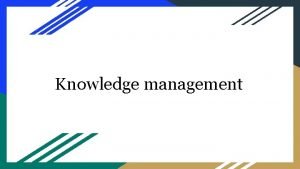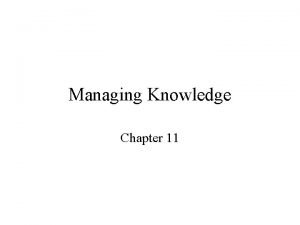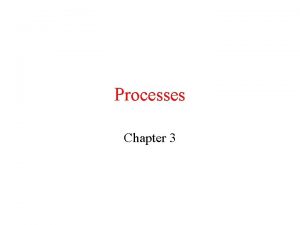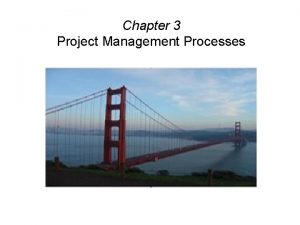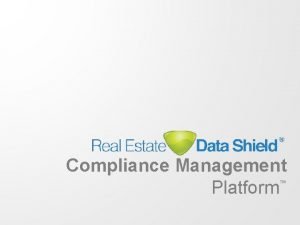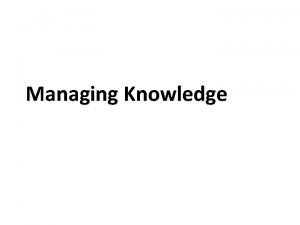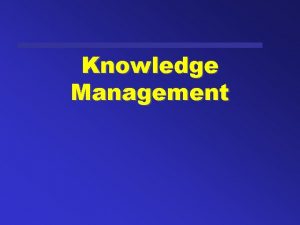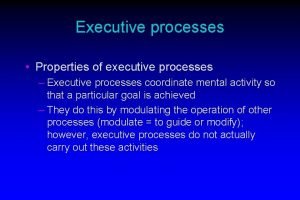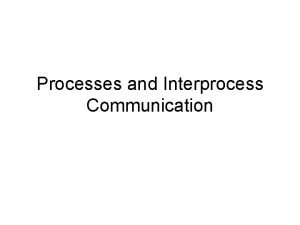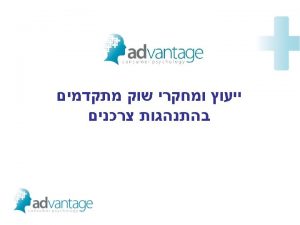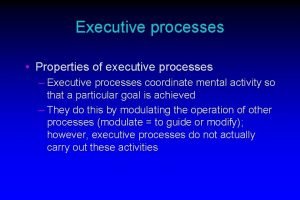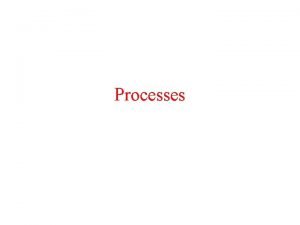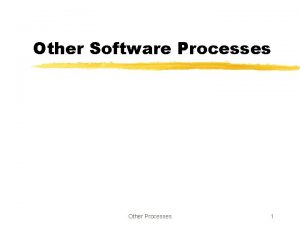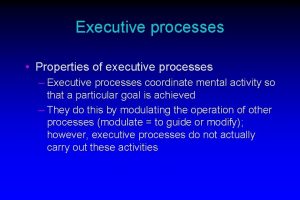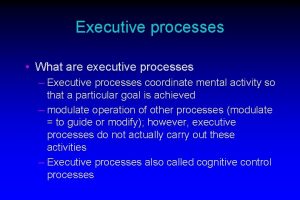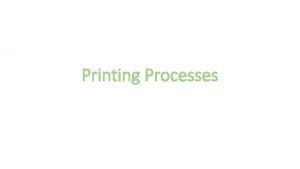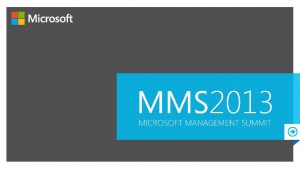Chapter 8 The Knowledge Management Platform Knowledge Processes







































- Slides: 39

Chapter 8 The Knowledge Management Platform

Knowledge Processes and Technology Enablers n n n Objective Technology Enablers Find knowledge Create new knowledge Package and assembler knowledge Apply knowledge Employee skills yellow pages DSS Tools Customized discussion groups Reuse and revalidate knowledge Chapter 8 Search, retrieval, and storage tools to help classify both formal and informal knowledge Customer support knowledge bases, Co. P, past project record database �Knowledge Management 2

Seven Layers of KM Architecture Chapter 8 �Knowledge Management 3

KM Platform basic needs n Efficient Protocol : secure and fast sharing of content across locations, mobile clients n Portable operation : OS environment in different departments n n n Consistent and easy to use client interfaces Scalability Legacy integration from mainframe database Security Flexibility and customizability : in term of. . “What the user sees and needs to see” The lack of the end user’s ability to filter out the irrelevant content is the root cause of information overload. Chapter 8 �Knowledge Management 4

Web or Proprietary Platforms? Chapter 8 �Knowledge Management 5

Packaging Knowledge n n n Packaging : Filtering, editing, searching, and organizing pieces of knowledge. Knowledge must be packaging in such a way that it’s insightful, relevant, and useful. Allow the employee the time to Package Knowledge for future use to make content useful 1. 2. 3. 4. 5. Chapter 8 Identification : general domain Segmenting : target users Mass Customization : suit each audience Format : use indexes, groupings, and table of contents Tests : refine the steps to seek feedback �Knowledge Management 6

Knowledge Delivery n PULL Approach – User Choice : Users want the knowledge – “Go and Get” what users need to know n PUSH Approach – You want the users to have the knowledge – Noticeability – Ease of use : workgroup Chapter 8 �Knowledge Management 7

Knowledge Delivery n ALL – Suit for information management not KM – Data Slam : meaningless piece of data, difficult to navigate n Some – Useful, contextually applicable pieces n When to deliver the knowledge JIT “JUST IN TIME” : Better – JIC “JUST IN CASE” : Information not knowledge, – people ignore them, lack of action-ability that is not relevant to their immediate work Chapter 8 �Knowledge Management 8

Source and Feeds for Marketing KM Chapter 8 �Knowledge Management 9

Chapter 8 �Knowledge Management 10

Data Warehouse in the KM Infrastructure Chapter 8 �Knowledge Management 11

Data Warehouse in the KM Infrastructure Data representing, such as hypercube data model in multiple dimensions, help in supporting decision making with concrete data from the past. n A data warehouse is of little use unless the data is converted to meaningful information and applied when needed. n Chapter 8 �Knowledge Management 12

GA Based Tools in the KM Technology Framework Chapter 8 �Knowledge Management 13

GA Based Tools in the KM Technology Framework Genetic Algorithms are based on Charles Darwin’s theory of natural selection. n “I don’t know how to build a good solution, but I will know it when I see it” n Chapter 8 �Knowledge Management 14

Neural Network in the KMS Architecture Chapter 8 �Knowledge Management 15

Neural Network in the KMS Architecture A neural network is a networked computing architecture in which a number of processors are interconnected like the neurons in a human brain that can learn through trial and error. n n. NN has their root of biology. n. Preprocess Chapter 8 data, cleaning up data, training data �Knowledge Management 16

Neural Network Chapter 8 �Knowledge Management 17

Rule-Based Systems in the KM Infrastructure Chapter 8 �Knowledge Management 18

Rule-Based Systems in the KM Infrastructure n n If. . . . then. . . . else. . Work well when 1. The rules do not overlap 2. You know the variables in your problem 3. You can express them quantitatively Chapter 8 �Knowledge Management 19

Case-Based Reasoning in KM Chapter 8 �Knowledge Management 20

Case-Based Reasoning in KM Each attribute is assigned some weight, based on previous experience or existing knowledge. Cases that are closest matches to the case at hand are then retrieved. n Chapter 8 �Knowledge Management 21

Case-based reasoning Chapter 8 �Knowledge Management 22

Applications of Various Intelligence Tools in a KM Platform Chapter 8 �Knowledge Management 23

Chapter 8 �Knowledge Management 24

A Comparison of Intelligence Tools Chapter 8 �Knowledge Management 25

Level of Increasing Granularity in a KM System Representing the System’s Depth of Detail Chapter 8 �Knowledge Management 26

Customer Support and Knowledge levels Chapter 8 �Knowledge Management 27

Tagging Attributed for Knowledge Content in a KM system Chapter 8 �Knowledge Management 28

Form Attributed n paper n electronic n formal (file, word document, spreadsheet) n informal (multimedia, sound, video tape) n tacit or mental knowledge pointer (to person who has solved a problem of that nature before) n Chapter 8 �Knowledge Management 29

Type Attributed n procedure n memo n guideline n failure report n protocol n success report n manual n press report n reference n competitive n worst practice report n best practice report n note Chapter 8 intelligence report �Knowledge Management 30

Product and Service Attributed n Strategic consulting n Implementation consulting n e-commerce consulting Chapter 8 �Knowledge Management 31

Systems Commonly Confused with Customer KM Platform Chapter 8 �Knowledge Management 32

Application Layer in the KM Platform Chapter 8 �Knowledge Management 33

The Application Layer n Pointer to expertise – Electronic yellow pages n Document Management is not the focus of KM initiative. – Convert only those pieces of information that are needed. n Multimedia , Video Clip – A picture is worth a thousand words. n Microsoft Net. Meeting Conference Software – 28000 desktop users at 250 sites around the world – No inconsistent documents n Virtual Meeting Chapter 8 �Knowledge Management 34

Peer-to-peer networking peer-to-peer networking support KM because it is closely mirrors face-to-face communication n peer-to-peer networking is defined as sharing resources by direct exchange between individual systems in a digital network n 1. it must rapidly get the right people involved n 2. it enable them collectively to apply their expertise n Chapter 8 �Knowledge Management 35

Peer-to-peer networking Network of friends and their friends n Automatically pass on question, Stop when 1. run out of time 2. one of the peer confirms having matching expertise Chapter 8 �Knowledge Management 36

SECI Model and IT support Chapter 8 �Knowledge Management 37

Discussion Group Chapter 8 n 1. What is Knowledge in your company? n 2. Tagging attributed for your knowledge Content. (Activity, Domain, Form, Type, Product/Service, Time, Location) p. 28 -31. n 3. Define what are pull technology and push technology in your KM system. p. 7 Chapter 8 �Knowledge Management 38

The End
 Concurrent processes are processes that
Concurrent processes are processes that Adaptancy
Adaptancy Hát kết hợp bộ gõ cơ thể
Hát kết hợp bộ gõ cơ thể Frameset trong html5
Frameset trong html5 Bổ thể
Bổ thể Tỉ lệ cơ thể trẻ em
Tỉ lệ cơ thể trẻ em Chó sói
Chó sói Tư thế worm breton là gì
Tư thế worm breton là gì Chúa sống lại
Chúa sống lại Môn thể thao bắt đầu bằng chữ đua
Môn thể thao bắt đầu bằng chữ đua Thế nào là hệ số cao nhất
Thế nào là hệ số cao nhất Các châu lục và đại dương trên thế giới
Các châu lục và đại dương trên thế giới Công thức tính độ biến thiên đông lượng
Công thức tính độ biến thiên đông lượng Trời xanh đây là của chúng ta thể thơ
Trời xanh đây là của chúng ta thể thơ Mật thư tọa độ 5x5
Mật thư tọa độ 5x5 101012 bằng
101012 bằng Phản ứng thế ankan
Phản ứng thế ankan Các châu lục và đại dương trên thế giới
Các châu lục và đại dương trên thế giới Thơ thất ngôn tứ tuyệt đường luật
Thơ thất ngôn tứ tuyệt đường luật Quá trình desamine hóa có thể tạo ra
Quá trình desamine hóa có thể tạo ra Một số thể thơ truyền thống
Một số thể thơ truyền thống Cái miệng bé xinh thế chỉ nói điều hay thôi
Cái miệng bé xinh thế chỉ nói điều hay thôi Vẽ hình chiếu vuông góc của vật thể sau
Vẽ hình chiếu vuông góc của vật thể sau Biện pháp chống mỏi cơ
Biện pháp chống mỏi cơ đặc điểm cơ thể của người tối cổ
đặc điểm cơ thể của người tối cổ Thế nào là giọng cùng tên?
Thế nào là giọng cùng tên? Vẽ hình chiếu đứng bằng cạnh của vật thể
Vẽ hình chiếu đứng bằng cạnh của vật thể Tia chieu sa te
Tia chieu sa te Thẻ vin
Thẻ vin đại từ thay thế
đại từ thay thế điện thế nghỉ
điện thế nghỉ Tư thế ngồi viết
Tư thế ngồi viết Diễn thế sinh thái là
Diễn thế sinh thái là Các loại đột biến cấu trúc nhiễm sắc thể
Các loại đột biến cấu trúc nhiễm sắc thể Số nguyên tố là số gì
Số nguyên tố là số gì Tư thế ngồi viết
Tư thế ngồi viết Lời thề hippocrates
Lời thề hippocrates Thiếu nhi thế giới liên hoan
Thiếu nhi thế giới liên hoan ưu thế lai là gì
ưu thế lai là gì Hổ đẻ mỗi lứa mấy con
Hổ đẻ mỗi lứa mấy con








































